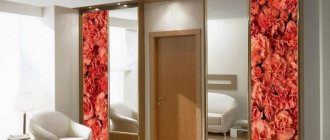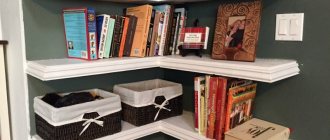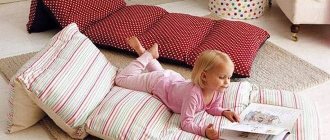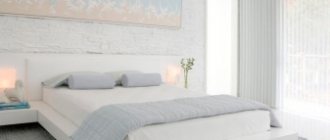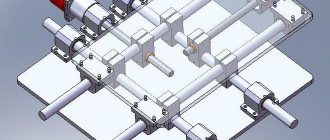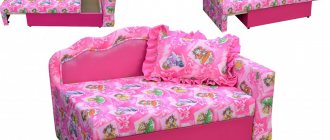A few centuries ago, the screen was a classic attribute of any interior that aspires to pretentiousness and taste.
Nowadays, screens can be used to regulate the space in the house.
Over time, fashion “pushed aside” the screen, turning it into an antique of interest only to fashion historians. Now, when the concept of zoning space is returning to the interior, the screen has again become necessary.
A screen is not just a decorative element, but a completely functional detail.
With its help, you can hide something that is not intended for prying eyes, complicate or make a space more comfortable, and also turn it into an art object, add theatricality and decorativeness, etc.
In the living room, a screen can be made the main decoration of the room.
Types of screens
Modern screens are divided into various types depending on the structure, materials used and purpose.
The original glossy screen serves as a decorative element.
And if the purpose of a screen can be very diverse and depends only on the imagination of its owner, then the most popular types by design are the following.
- Casement.
Until recently, this was the only possible type of screen. A rigid sash frame with fabric stretched over it (paper, glass inserted into the frame, etc.), the sash is connected to each other like an accordion.
A screen along the entire length of the room along the wall acts as a decorative element.
The fastening is made with furniture or piano hinges, in some cases with strong soft material (leather, thick fabric, artificial leather). Initially, the frame was made of wood, but later it was replaced with lighter aluminum.
Currently, the main material for folding screens is plastic.
- Single screen.
This is the main type of office screens. It is used when it is necessary to divide a large space into smaller, individual “offices”.
An unusual single-screen screen in a relaxation corner.
- Composite.
Recently, this type has become especially popular among those who like dramatic changes in their interior. This screen is assembled like a puzzle from several elements. The material is usually plastic, but a textile option is also possible.
In this case, you can choose the number of elements, the material for them and in what order they will go in yourself.
- Flexible.
This type of screen is the latest invention of designers. The structure does not consist of separate doors, but is a single wall made of flexible material.
The screen can be easily rolled up if necessary, can take fancy shapes and be used in various situations.
It can be bent at almost any angle, creating not only small zones in space, but even labyrinths. If necessary, the screen is folded and removed.
A new product in the world of partitions is a flexible screen.
If you are faced with the question of how to make a screen with your own hands, then you need to proceed from the design features. For example, it is not possible to make a flexible screen yourself, because it’s all about the material. Such a screen can be subjected to design changes or assembled independently.
Making a classic folding screen with your own hands is quite possible.
At the same time, such a screen will have an undoubted number of advantages:
- The material is selected based on your own preferences, as well as configuration, height, width, etc.;
- The screen will ideally “fit” into the interior in size, design, color, and style;
- The price for such an individual design is significantly lower than any other analogues;
- If desired, you can involve additional people in production, for example, woodworkers, artists or professional decorators.
Since screens are made from a variety of materials, it is important not to make a mistake in choosing one for a particular room.
A screen for a room can be not only functionally useful, but also decoratively beneficial.
Decorative cardboard screen
The easiest way to make a partition is to take cardboard pipes onto which linoleum is screwed. They can be found at home if you have recently done renovations or bought inexpensively in a store.
What we will need:
How to make a screen partition from cardboard:
1. Place the pipes exactly next to each other to mark the same height. Next, we lay out our blanks, make markings, retreating 20 cm from the edge. If the pipes are of different lengths, we align them.
2. We retreat 1 meter from each mark and make a new mark. Next, between these points we find the center and mark it. We make small holes at the marks with a drill.
3. We pass the rope through the holes, thereby connecting the workpieces to each other.
4. We fix the knots at the ends. We decorate the product to your taste.
Materials and tools needed to make a screen
Making a screen with your own hands is not a difficult process at all. Having done this for the first time, in the future, having the necessary tools and experience, you can independently improve the technology and develop unique design solutions. But for the first screen you will need a minimum set of tools and materials. Namely:
- Screwdriver and drill;
- Construction stapler;
- Furniture hinges;
- Hacksaw;
- Screws;
- Paint, varnish;
- Wood blocks of the required length;
- Fabric for the internal filling of the sashes (if glass is used, additional glazing beads will be needed);
- Suitable decor.
If everything you need is available, you can begin production.
The manufacturing process, in turn, is divided into the production of frames for the sashes, decoration and fastening of the sashes.
Partition made from blind doors
And now we suggest you make a stylish partition from louvered doors that will fit into most modern designs if you choose the right shade.
What we need for work:
So, how to make a screen:
1. Place the shields exactly on top of each other with the front side facing you. We mark places for fixing the loops.
2. Fix the loops. If the structure is large, more fastenings will be needed.
3. We fix the shields so that they stand firmly, you can ask someone to help, and then screw in the screws.
4. Next we attach the third shield. Remember that all three parts should be facing forward and open like an accordion.
5. Now we start painting with acrylic. A universal option is white, which will suit any interior.
After our master classes, you can easily make a simple partition and divide the room into several zones.
Source
Decorating the screen
Based on the method of decoration, structures are divided into solid and transparent. Based on this, the material to fill the frame is selected. If the final product is planned to be transparent or translucent, choose glass. It can be corrugated, matte, mosaic, painted, etc.
For glass, recesses are made in wooden blocks, then it is secured with glazing beads.
Another material suitable for translucent screens is sisoflor. But it is difficult to work with; it is quite fragile. Sometimes, when creating a multifaceted decor, transparent sections of the screen are combined with non-transparent ones. For the latter, cardboard is used.
Cardboard is combined with floral mesh, paper, and foil.
The most used material is fabric. And here the scope of designer imagination is simply limitless: chintz, exquisite silk, embroidery, organza, tapestry, fabric painting, etc.
There are practically no restrictions in decor.
There are also quite a few types of fastening fabric to a block frame:
- Using a construction stapler;
- Pull onto the slats;
- Using decorative loops;
- “Plant” on glue with a rubber base;
- Using specialized pins.
Over time, when making a screen with your own hands, each craftsman develops his own secrets, methods of fastening and decoration.



